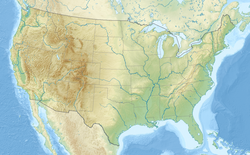Needle Point is a mountain summit located in Union County, Oregon, US.[4]
| Needle Point | |
|---|---|
 Northeast aspect, centered at top | |
| Highest point | |
| Elevation | 9,018 ft (2,749 m)[1][2] |
| Prominence | 1,458 ft (444 m)[2] |
| Parent peak | Eagle Cap (9,577 ft)[2] |
| Isolation | 3.47 mi (5.58 km)[3] |
| Coordinates | 45°07′39″N 117°21′08″W / 45.127418°N 117.352214°W[2] |
| Geography | |
| Location | Eagle Cap Wilderness |
| Country | United States of America |
| State | Oregon |
| County | Union |
| Parent range | Wallowa Mountains |
| Topo map | USGS Eagle Cap |
Description
editNeedle Point is located in the Wallowa Mountains and is set within the Eagle Cap Wilderness, on land managed by Wallowa–Whitman National Forest.[2] The remote 9,018-foot elevation (2,749 m) peak ranks as the 50th-highest mountain in Oregon.[3] The peak is situated 3.5 miles southwest of line parent Eagle Cap.[2] Precipitation runoff from the mountain drains north to Minam River via Pop Creek, and south into headwaters of Eagle Creek. Topographic relief is significant as the summit rises 2,600 feet (790 meters) above Eagle Creek in one mile. This landform's toponym has been officially adopted by the United States Board on Geographic Names.[4]
Climate
editBased on the Köppen climate classification, Needle Point is located in a subarctic climate zone characterized by long, usually very cold winters, and mild summers.[5] Winter temperatures can drop below −10 °F with wind chill factors below −20 °F. Most precipitation in the area is caused by orographic lift. Thunderstorms are common in the summer.
See also
editReferences
edit- ^ United States Geological Survey topographical map - Eagle Cap
- ^ a b c d e f "Needle Point, Oregon". Peakbagger.com. Retrieved 2022-10-08.
- ^ a b "Needle Point - 9,018' OR". listsofjohn.com. Retrieved 2022-10-08.
- ^ a b "Needle Point". Geographic Names Information System. United States Geological Survey, United States Department of the Interior. Retrieved 2022-10-08.
- ^ Peel, M. C.; Finlayson, B. L.; McMahon, T. A. (2007). "Updated world map of the Köppen−Geiger climate classification". Hydrol. Earth Syst. Sci. 11: 1633–1644. ISSN 1027-5606.
External links
edit- Weather forecast: Needle Point
- Needle Point (photo): Flickr
- Needle Point (photo): Flickr

